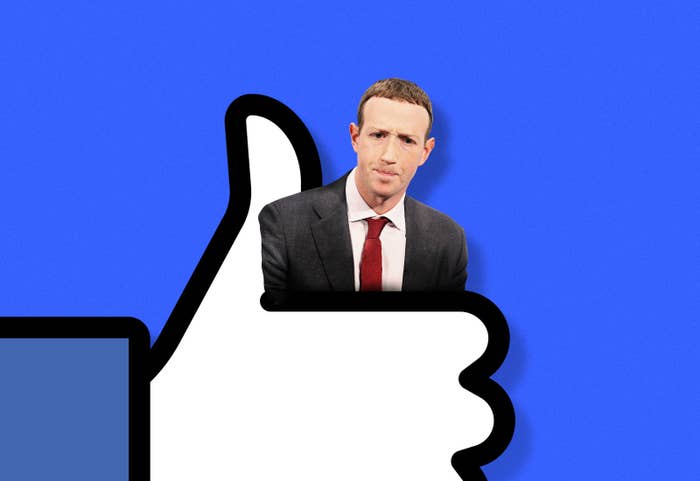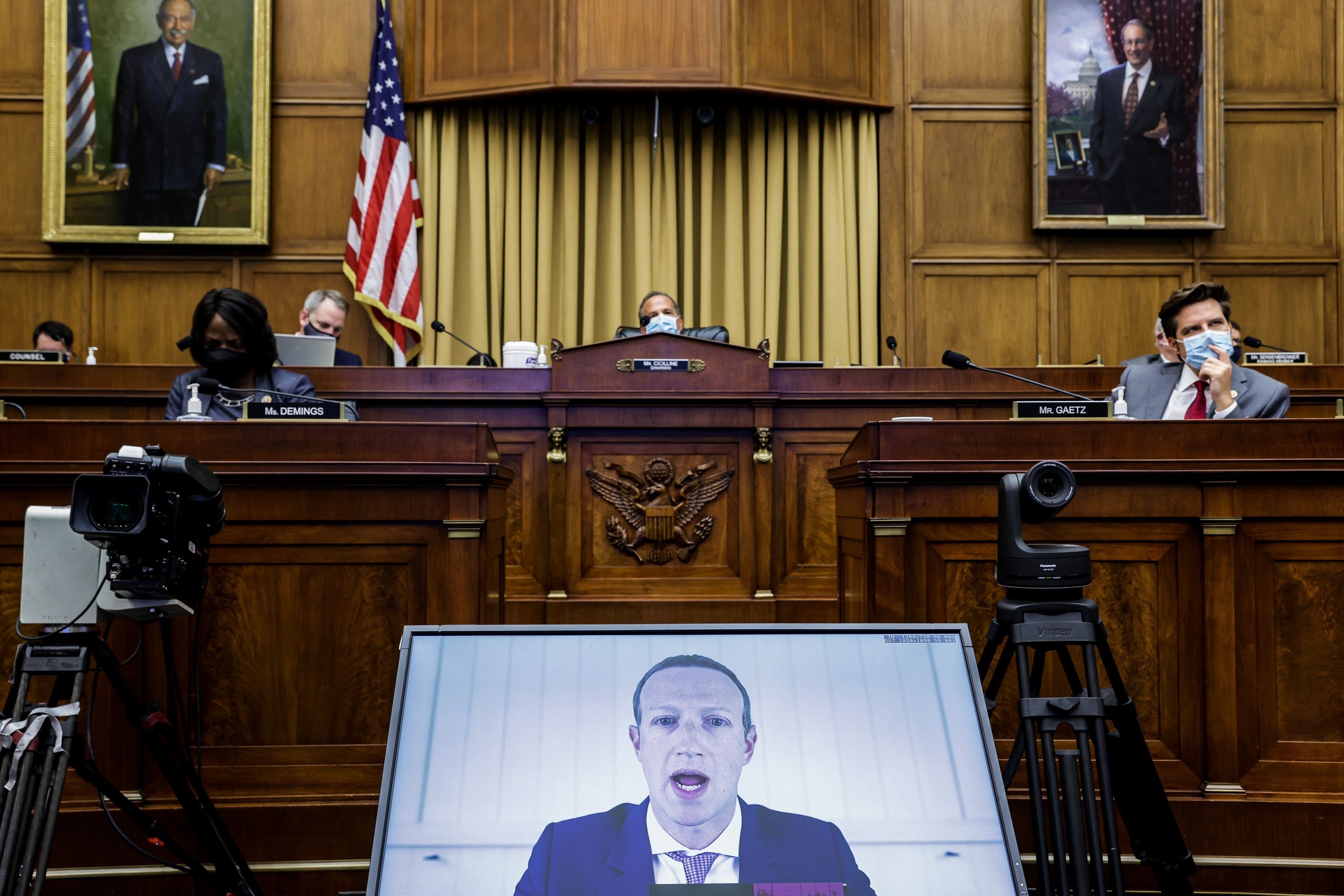
Last week, Republican Rep. Jim Jordan asked a question at a Congressional hearing that seemed to come out of nowhere. While the biggest tech CEOs — Facebook’s Mark Zuckerberg, Amazon’s Jeff Bezos, Apple’s Tim Cook, and Google’s Sundar Pichai — were being questioned about antitrust violations and harm they’ve done to consumers, Jordan used his valuable time to ask about...cancel culture?
The laughs came in hot. It was “the dumbest question,” internet commenters charged. Jordan quickly joined the inglorious canon of technologically challenged lawmakers who are seemingly unable to hold tech CEOs accountable with actually good questions (remember Zuckerberg’s “Senator, we run ads” moment?).
But here’s the thing: Even though the question was badly phrased (“Is the cancel culture mob dangerous?”) — and its messenger wasn’t great either — the setting was absolutely right. For all the noise that gets made about “cancel culture,” it is in fact technology companies who should have to answer for it. The way we talk on the internet is broken, and users are not the ones who broke it — tech companies did that, and they did it for profit.
The idea of “canceling” originated in Black Twitter. It first described a relatively benign form of cultural boycott: a group of people making the case for others to withdraw their support from an individual or an institution. Boycotts aren’t new, obviously. But sometime within the last two years, the phrase “cancel culture” picked up steam and morphed into a monstrosity, a catchall phrase for heightened internet discourse, colored in with words like “dangerous mob.”
The panic is in part due to a wide range of behaviors that have become linked with so-called cancel culture: Run-of-the-mill boycott efforts like campaigns to encourage others to unfollow someone on social media or calls to withdraw someone’s invitations to speak at events (particularly at universities) got lumped in with groups lobbying employers to fire employees for any given reason.
A few critics, like New York magazine’s Jonathan Chait, have argued that these behaviors go beyond your regular ol’ fashion boycott — that, in fact, they amount to “the expression of a political culture with consistent norms, and philosophical premises that happen to be incompatible with liberalism.” Through intimidation, these critics charge, the cancel-happy internet is threatening the foundations of liberalism itself, creating expectations of conformity.
What we now broadly consider “cancel culture” is in fact a convergence of three relatively new forces: the easiest access to like-minded people in the history of humanity; a technology-facilitated culture of rapid feedback; and the conflation of Twitter with some sort of huge and all-important public square.
These forces are incredibly powerful, and they are changing our world. But they do not present people problems so much as they present a technology problem. And for all too many — particularly conservatives and centrists stoking the fires of the culture wars — it’s easy to mistake these problems for a single coherent ideology that really doesn’t exist.
Our behaviors on these platforms are too often conflated with who we are.
It’s perhaps true that the stakes of being wrong in public — or at least, being perceived by somebody, somewhere, as being wrong — are higher now than they were even a decade ago. It’s also true that a lot of people feel like they can’t freely speak on social media because of those stakes. This mood is, more or less, what critics mean when they say “cancel culture.” But this mood, far from a rot at the core of liberal society, is actually a direct result of how technology companies have set up our arena of digital speech, and the consequences it has had on our institutions.
Our behaviors on these platforms are too often conflated with who we are. This is to our detriment. We forget that the platforms themselves impact behavior, mediate it, intercept it, and reframe it. Angela Xiao Wu from New York University, writing about how we analyze platform data, argues that “platform data do not provide a direct window into human behavior. Rather, they are direct records of how we behave under platforms’ influence.” It’s another way of saying that understanding ourselves based on what we do on these platforms completely overlooks the fact that the platforms themselves are not neutral.
Technology companies have goals. They have capitalist interests in how much time you spend on the platforms, how much you engage, how often you return to them again and again and again. All of these elements can be further manipulated for political gain. The ways we congregate online is a result of a bunch of people trying to make money. That’s how we ended up here.
Facebook and Twitter have positioned themselves as the new public square. This is not a paraphrasing — both Zuckerberg and Twitter CEO Jack Dorsey have referenced their platforms as such. But heralding themselves as champions of free speech on ginormous scales just obfuscates their actual purpose: to monetize our interactions in order to grow. Joan Donovan, the research director at Harvard’s Shorenstein Center on Media, Politics, and Public Policy, told me that social media platforms “calling themselves the public square was a clever ploy from the get-go to avoid regulation.”
It also helps them avoid any semblance of responsibility for what they have created: environments that are, by design, optimized for emotional and divisive content, and mysterious algorithms that seem to be aimed at maintaining audience attention even at the expense of damaging digital conversation. Many academics, reporters, and thinkers have argued that these platforms do far more harm than good — to the point where abolishing them may be the only solution: “All signs point to a system beyond reform,” writes Charlie Warzel in the New York Times.
The sites on which much of the cancel culture conversation takes place are the reason this notion exists in the first place. As such, tech CEOs should absolutely be questioned on “cancel culture” — by which I mean: the consequences of the rules they’ve set up for online speech.

It is undeniably true that people who are upset at something can quite easily find more people who are upset at the same thing. This is a boring observation in 2020, but that’s only because we have entirely lost sight of how new this is. In 2003, if you belonged to a group that was mad about a newly published op-ed, the group could yell about it over MSN Messenger. If it were a particularly passionate group, you might even have a forum on a website. But that was the extent of your digital protest.
Now, you and I could latch onto a hashtag and find each other, and within a few hours, we could become a united force. But in doing so, observers risk overemphasizing strangers’ political alignment. People who are unified about one thing for a brief moment — say, disapproving of the New York Times’ editorial decision to run a reckless opinion piece by a senator — are not politically aligned forever. They don’t trade ideas on how to elect a replacement senator. There is no Cancel Party of the USA. They are not a “culture” — they are hardly a movement.
But algorithms intent on driving more emotional content to users have allowed for thriving hyperpartisan echo chambers that hinge on feeding an outrage machine. Disparate individuals who might share a few perspectives politically are lumped together indiscriminately, until they are an indistinguishable mass.
Even still, expressing frustrations with an individual or an institution’s actions aren’t new. What’s changed has been the dynamic of feedback culture. Institutions used to receive disconnected pieces of feedback you know, letters in the mail they could ignore, emails they could delete. But now, institutions can face swells of criticism in real time — and when they see their name in the unfortunate lights of the trending bar, they might feel more pressured to act.
This effect, too, can be laid at the feet of technology companies. And it is not always a bad thing. Horrible people who might never have been held accountable for their bigoted speech or offensive actions have been forced to face consequences in ways that may never have happened before the digital age. Those held to account by the #MeToo movement, for example, are facing real-life consequences like canceled contracts and prison time — not just digital ones.
Of course, those instances are still rare. (And there’s always the argument that digital campaigns like #MeToo have gone too far.) And all too often, companies are scared into responding to bad faith attacks.
Take, for example, the case of the Federal Reserve of Chicago, which cut ties with economist Harald Uhlig after he tweeted that the Black Lives Matter movement “torpedoed itself” by backing the idea of defunding the police. The Fed said Uhlig’s views do not match its “commitment to diversity, equity and inclusion.” Uhlig’s view is hardly controversial — it’s status quo to be skeptical of defunding the police. But Uhlig’s tweet drew heat, and the decision was clearly aimed at ending a PR nightmare.
There’s also the case of David Shor, the data analyst who was fired after he tweeted a thread on the work of another professor, whose research showed why peaceful protests work. Civis Analytics, the progressive firm Shor worked for, received some blowback, and shortly after, Shor was fired.
The villain you’re looking for — the real cancel culture — is at-will employment.
The light-speed acceleration of feedback culture has left institutions reeling, unsure how to react to a deluge of responses. In some cases, it’s forced companies to speak where they otherwise wouldn’t, and it’s yielded some odd results. Like, it’s nice that Gushers finally weighed in on Black Lives Matter — and that more companies and individuals are being encouraged via social media peer pressure to at least seem like they care about Black lives, regardless of what they’re actually doing behind the scenes — but I’m not sure that’s the one I was waiting for.
But here, where some see cancel culture’s insidious reach in these stories, I see only baffling cowardice. If a bank or a journalism institution or a research firm believes no rules were broken by their employees or associates, they have to figure out how to articulate that when the angry tweets come. People on Twitter do not have the capacity to hire and fire a person — HR departments do, and no number of tweets can change that. “We’re trending and worried about it” is not just cause. The villain you’re looking for — the real cancel culture — is at-will employment, and the ability of employers to dismiss an employee without legitimate reasons.
The “trending” culture that technology companies have built has created the illusion that whatever a few people are yelling about online is what really matters on any given day. It’s all smoke and mirrors: An algorithm drives a conversation to your feed, then it tells you it matters because the people it drove to your feed are talking about it. For institutions navigating large amounts of feedback, it’s created a fear of trending, a desire never to be the main character, and an incentive to cut ties with the source of social media heat — no matter that the next day some other poor sap will be at the center of the outrage machine.
These conversations almost always start brewing on a platform like Twitter. And Twitter is my home address, too, but too often those of us among “the chattering class” (journalists, politicians, academics, and media people) treat the platform as if it matters more in the real world than it actually does. Like Twitter can stop the flow of time and reverse the effects of gravity. It’s enough to make you forget that most people aren’t on the site.
Sometimes, of course, what happens on Twitter has significant real-life consequences. But for the most part, the topics that trend, and the articles that get shared, are treated as distillations of society’s most important discourse, when it’s mostly just driftwood in the sea of K-pop stans and Harry Styles fan accounts. Institutions choose to be beholden to people’s opinion if they want to be, but this does not make for a tangible culture.
Twitter is changing how I think, and I hate it. In a recent interview, Jenny Odell, author of How to Do Nothing, wonders how being Extremely Online affects our thoughts. Not the thoughts themselves, but how the thoughts get formed.
It’s a disturbing revelation — that our minds are being molded by these platforms. For some, especially those particularly concerned about so-called cancel culture, the scariest element of these changes is that an apparent epidemic of self-censorship abounds, that we’re all more afraid to speak our minds than ever before. Some of the fanciest famous people signed an open letter in Harper’s Magazine to this effect last month, decrying that “censoriousness is spreading more widely in our culture.”
Well, what changed? Is it that people are suddenly shakier in their convictions? Or is it perhaps that we went from expressing views to our friends and families, people who likely wouldn’t “cancel us,” to expressing views on public platforms that could be viewed by anyone in any part of the world at any given time? Maybe we were never meant to shout across a room of millions, and maybe the people who designed the room should be held responsible for the echo that bounces off the walls perpetually until we mistake it for conversation.
Take the panic over the supposed deficit of tolerance toward conservative views on college campuses. This imagined deficit has been the subject of complaint at least since William F. Buckley wrote God and Man at Yale in 1951 — he protested left-wing professors and books that teach collectivism way before it was cool. But there’s plenty of solid research that suggests that actually, universities make people more tolerant of both conservative and liberal views, not less.
Maybe we were never meant to shout across a room of millions.
You wouldn’t know this, of course, if you were to read the tone and tenor of the online discussion about universities, optimized for clicks and decked out in front of the trick mirror. You’d come away thinking that universities are the site of a battle over speech the likes of which humanity has never seen.
The Canadian media thinker Marshall McLuhan wrote at length about how mediums themselves influence how we think and act. Eventually, he argued, we start reacting less to new information delivered by a medium, and more to the rhythms of the medium itself. He was writing about our journey from the printed press to television. Boy, would he have hated *gestures broadly* this.
In the Jenny Odell interview, she brought up a suggestion I can’t get out of my head. Here’s the pitch: What if we stressed less about how we position things to “people who have no context for us” (i.e., the faceless internet), and redirected that energy toward saying the right thing to people who have actually have context for what we believe and who we are?
So many critiques of “cancel culture” are missing the disease for the symptoms. The actual problem is that we’ve been given faulty technological tools with which to have a digital conversation. Even Twitter has acknowledged that it needs to do more to create healthier conversations.
When asked about cancel culture during the antitrust hearing, CEO Jeff Bezos described social media as a “nuance destruction machine.” When Mark Zuckerberg’s turn came, he expressed concern about “forces of illiberalism in this country...that are pushing against free expression.”
If only there were someone in the room who could answer for social media platforms and the ways they have warped online speech. ●
